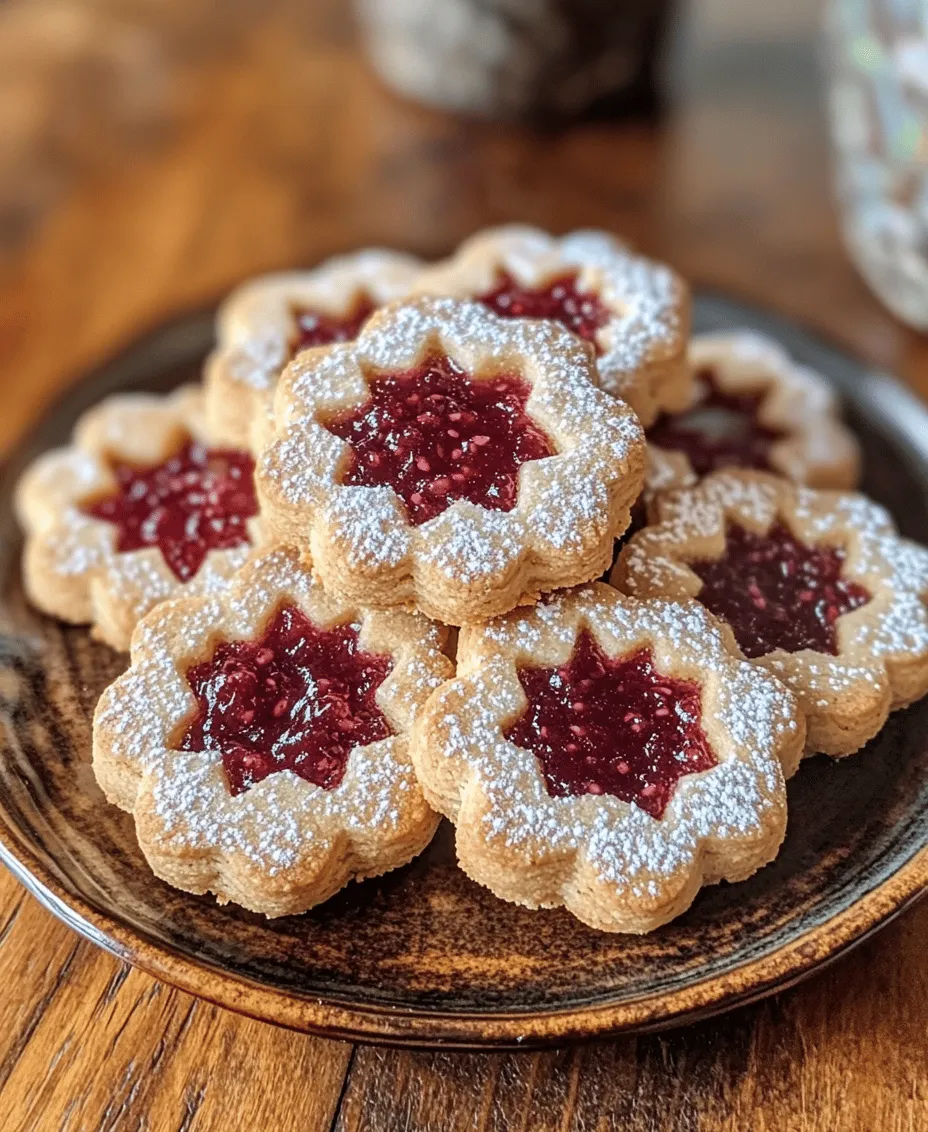Introduction
Linzer cookies are a delightful treat that perfectly balances flavor and texture, making them a favorite among cookie enthusiasts. With their delicate construction, these sweet delights are filled with luscious jam and dusted with powdered sugar, creating a beautiful presentation that appeals to both the eyes and the palate. Traditionally, Linzer cookies hail from Linz, Austria, where they have been enjoyed for centuries. However, in today’s culinary landscape, where dietary restrictions are more common than ever, the gluten-free adaptation of this classic recipe has gained significant popularity.
The gluten-free version of Linzer cookies employs almond flour, which not only provides a delightful nutty flavor but also caters to those with gluten sensitivities or celiac disease. These cookies are not just for the holidays—though they shine during festive gatherings; they make for a sweet indulgence at any time of the year. Whether you’re hosting a party, attending a potluck, or simply craving a treat at home, these irresistible gluten-free Linzer cookies are sure to impress.
The History of Linzer Cookies
Tracing the origins of Linzer cookies takes us back to Linz, Austria, where the recipe is believed to have originated in the 17th century. The cookies were named after the Linzer Torte, a tart composed of a rich pastry crust filled with jam, typically made from red currants or raspberries. Over time, the concept of this dessert evolved into the handheld cookies that we enjoy today.
Traditionally, Linzer cookies are made using a buttery dough enriched with almonds and flavored with spices like cinnamon and lemon zest. The dough is rolled out, cut into shapes, and sandwiched around a layer of jam, often dusted with powdered sugar to create a snowy finish. Variations of Linzer cookies have sprung up in different cultures, each adding its own twist—some using different types of nuts or flavors, while others may incorporate various jams.
In recent years, the demand for gluten-free options has surged, leading many bakers to experiment with gluten-free flours to create versions of classic recipes like Linzer cookies. These adaptations not only cater to those with dietary restrictions but also highlight the versatility of gluten-free baking, proving that one can enjoy traditional flavors without compromising on health or taste.
The Benefits of Gluten-Free Baking
Gluten-free baking is essential for individuals diagnosed with celiac disease or those who experience gluten sensitivities. Celiac disease is an autoimmune disorder affecting the small intestine, triggered by the ingestion of gluten—a protein found in wheat, barley, and rye. For those affected, consuming gluten can lead to serious health issues, making gluten-free recipes a necessity.
The gluten-free adaptation of Linzer cookies utilizes almond flour and gluten-free all-purpose flour, both of which provide nutritious alternatives to traditional wheat flour. Almond flour, made from finely ground almonds, offers several health benefits. It is rich in protein, healthy fats, and fiber, making it a more nutrient-dense option compared to all-purpose flour. This results in cookies that not only taste delicious but also provide a satisfying energy boost.
Gluten-free all-purpose flour blends often combine various gluten-free ingredients, such as rice flour, tapioca starch, and potato starch, to mimic the texture and binding properties of wheat flour. These blends typically include xanthan gum or guar gum, which help create the structure needed for baked goods. By using these gluten-free alternatives, bakers can enjoy the same delightful textures and flavors associated with traditional baking while adhering to a gluten-free diet.
Ingredients Breakdown
To craft these irresistible gluten-free Linzer cookies, an array of carefully selected ingredients is essential. Each component plays a vital role in achieving the desired flavor and texture:
– Almond Flour: This key ingredient lends a nutty flavor to the cookies while providing a moist and tender crumb. Almond flour is rich in protein and healthy fats, making it a nutritious choice for gluten-free baking. Its low carbohydrate content also makes it popular among those following low-carb or ketogenic diets.
– Gluten-Free All-Purpose Flour: This blend is designed to substitute regular flour in baking recipes. It typically includes a combination of gluten-free flours such as rice flour, tapioca flour, and potato starch. The blend’s purpose is to replicate the texture and consistency of traditional all-purpose flour, ensuring that your cookies hold their shape and have a tender bite.
– Powdered Sugar: This ingredient is crucial for achieving a smooth texture in the cookies. Powdered sugar dissolves easily, preventing a gritty texture in the dough. It also contributes a delicate sweetness that perfectly complements the tartness of the jam filling.
– Unsalted Butter: Butter is a cornerstone of baking, adding richness and flavor to the cookies. Using unsalted butter allows you to control the overall saltiness of the recipe, ensuring a balanced flavor profile. The fat content in butter also contributes to the cookies’ tender and crumbly texture.
– Egg: Eggs serve multiple purposes in baking. They act as a binding agent, helping to hold the ingredients together and provide structure to the cookies. Additionally, eggs add moisture, contributing to the overall softness of the final product.
– Vanilla and Almond Extracts: These extracts are essential for enhancing the cookies’ flavor. Vanilla extract provides a warm and sweet undertone, while almond extract amplifies the nutty notes from the almond flour, creating a harmonious flavor profile.
– Ground Cinnamon and Salt: Ground cinnamon adds a warm spice that complements the sweetness of the cookies and the tartness of the jam. A pinch of salt balances the flavors, enhancing the sweetness and ensuring a well-rounded taste.
With these ingredients in hand, you’re ready to embark on the delightful journey of creating gluten-free Linzer cookies. In the next section, we will delve into the step-by-step instructions for crafting these delicious treats, ensuring that you achieve perfect results every time. Stay tuned for a baking adventure that promises to fill your kitchen with irresistible aromas and a batch of cookies that are simply too good to resist!
Jam Filling
When it comes to filling your gluten-free Linzer cookies, the choice of jam can elevate the flavors and add a delightful touch. Here are some popular jam flavors that pair beautifully with these cookies:
1. Raspberry Jam: The tartness of raspberry jam complements the buttery sweetness of the cookies perfectly, providing a vibrant burst of flavor.
2. Apricot Jam: This sweet and slightly tangy option adds a lovely color and a unique taste that works wonderfully with the almond flour base.
3. Strawberry Jam: A classic choice, strawberry jam brings a familiar sweetness that appeals to many, making it a safe yet delicious option.
4. Blackcurrant Jam: For those who enjoy a more robust flavor, blackcurrant offers a richer taste that contrasts nicely with the cookie’s sweetness.
5. Mixed Berry Jam: Combining multiple berries can create a complex flavor profile that enhances the overall experience of the cookies.
6. Peach Jam: The sweet and floral notes of peach jam provide a refreshing twist that pairs well with the nuttiness of the cookies.
Feel free to experiment with different flavors or even create your own blend to find the perfect fit for your Linzer cookies.
Step-by-Step Instructions
Preheating and Preparation
Start by preheating your oven to 350°F (175°C). Preheating is essential as it ensures your cookies bake evenly, resulting in a consistent texture. While the oven warms up, line two baking sheets with parchment paper or silicone baking mats. This prevents sticking and makes cleanup a breeze.
Mixing Dry Ingredients
In a medium bowl, whisk together 2 cups of gluten-free all-purpose flour, 1 teaspoon of ground cinnamon, and 1/2 teaspoon of salt. Mixing these dry ingredients thoroughly helps to distribute the leavening agent evenly, which is crucial for achieving the right rise and texture in your cookies.
Creaming Butter and Sugars
In a large mixing bowl, combine 1 cup (2 sticks) of softened unsalted butter with 1/2 cup of granulated sugar and 1/2 cup of powdered sugar. Using an electric mixer, cream the mixture on medium speed until it becomes light and fluffy, about 3 to 5 minutes. This process incorporates air into the butter, which is key for a tender cookie.
Adding Wet Ingredients
Once your butter and sugars are well combined, add in 1 teaspoon of vanilla extract and 1 large egg. Mix until the wet ingredients are fully incorporated. Be careful not to overmix, as this can lead to tougher cookies.
Chilling the Dough
After combining your wet and dry ingredients, you will have a soft dough. To make it easier to handle, wrap the dough in plastic wrap and refrigerate it for at least 30 minutes. Chilling the dough firms it up, making it less sticky and easier to roll out.
Rolling Out the Dough
Once chilled, remove the dough from the refrigerator and place it on a lightly floured surface. Using a rolling pin, roll it out to about 1/8-inch thickness. To prevent sticking, you can dust the surface and the rolling pin with a bit of gluten-free flour. Use cookie cutters to cut out shapes—traditionally, these are circular with a smaller hole in the center for the Linzer design.
Baking Process
Transfer the cut-out cookies onto your prepared baking sheets, leaving some space between each cookie as they will expand slightly while baking. Bake in the preheated oven for 10-12 minutes, or until the edges are lightly golden. To judge doneness, look for a slight browning around the edges and a firm texture.
Cooling and Assembly
Once baked, let the cookies cool on the baking sheets for 5 minutes before transferring them to a wire rack to cool completely. This step is crucial; if you try to assemble the cookies while they are still warm, the jam may melt and ooze out.
Once cooled, take half of the cookies and spread a generous teaspoon of your chosen jam in the center of each. Place the remaining cookies on top, pressing gently to adhere.
Decorating Linzer Cookies
The final touch to your Linzer cookies is decoration. Lightly dust the tops with powdered sugar for a classic look. For a festive twist, consider using icing to drizzle over the cookies or adding decorative toppings such as sprinkles or edible glitter. These small touches not only enhance the appearance but also elevate the overall experience of enjoying these treats.
Serving Suggestions
These gluten-free Linzer cookies are a delightful treat that can be served in various ways. Here are some suggestions:
– Pairing with Beverages: Serve your cookies alongside a warm cup of tea or coffee. The rich flavors of the cookies complement the aromatic notes of these beverages, creating a comforting snack experience.
– Gift Packaging: If you plan to share your cookies with friends or family, consider packaging them in decorative boxes or tins. Layer the cookies with parchment paper and tie them with a ribbon for an elegant presentation.
– Special Occasions: These cookies can be a wonderful addition to holiday gatherings or parties. Their festive look and delightful taste make them a crowd-pleaser.
Conclusion
Making gluten-free Linzer cookies is not only a satisfying culinary experience but also a wonderful way to share joy with others. The process of creating these traditional treats accommodates modern dietary needs while still delivering on flavor and nostalgia. With their delicate texture, rich flavors, and beautiful appearance, these cookies are sure to be a hit at any gathering.
Encourage your friends and family to join you in this baking adventure, and relish the delight of crafting something special. Whether enjoyed with a cup of tea, given as gifts, or simply savored alone, gluten-free Linzer cookies are a testament to the joy of baking and sharing delicious food. So gather your ingredients, follow the steps, and indulge in the delightful combination of flavors and textures that these cookies offer. Happy baking!



